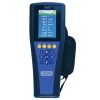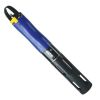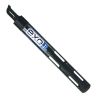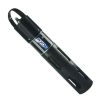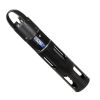YSI EXO2 Multi-Parameter Water Quality Sonde
Features
- Titanium sensors with wet-mateable, universal sensor ports
- Biofouling protection with central wiper brush and copper-alloy accessories
- Smart QC automatically checks for faults and errors to ensure successful deployments
- Expedited repair and warranty service
- Lifetime technical support
- More
Modern and Efficient Design
The YSI EXO2 represents an advanced sonde platform that offers a wide range of capabilities to those dedicated to monitoring natural aquatic environments such as oceans, estuaries, rivers, lakes, and groundwater. With a highly efficient power management platform, robust construction, and chemistry-free anti-fouling system, The EXO2 allows accurate data collection for up to 90 days between service intervals.
Multi-Port Water Quality Sonde
- Temperature
- Conductivity
- Depth
- Dissolved oxygen
- pH
- ORP
- Total algae (phycocyanin or phycoerythrin along with chlorophyll)
- Turbidity
- Fluorescent dissolved organic matter (fDOM)
- Rhodamine WT
- UV nitrate
- ISE ammonium
- ISE nitrate
- ISE chloride
Outputs Four Calculated Parameters
- Salinity
- Specific conductance
- Total dissolved solids (TDS)
- Total suspended solids (TSS)
Onboard Signal Processing and Memory
All EXO sensors are digital sensors with onboard signal processing and memory. Built-in sensor diagnostic and calibration data allow users to calibrate multiple sensors in one sonde and distribute them to various other sondes in the field. Wet-mateable connectors allow for swaps in wet conditions, while active port monitoring automatically detects each sensor and verifies operation.
EXO2 Specifications
Diameter: 7.62cm (3.00 in)
Length: 71.10cm (28.00 in)
Peripheral Ports: 1 power communication port; 1 auxiliary port for third-party sensors (future functionality; not active yet)
Sensor Ports: 7 (6 ports available when central wiper used)
3-Year Warranty: Sonde; handheld
2-Year Warranty: Cables; conductivity/temperature and optical sensors; electronics base for pH, pH/ORP, ammonium, chloride, and nitrate sensors
1-Year Warranty: Optical DO cap and replaceable reagent modules for pH and pH/ORP sensors
3-Month Warranty: Replaceable reagent modules for ammonium, chloride, and nitrate sensors
Weight: 3.60kg (7.90 lbs)
General Sonde Specifications
Battery Life: 90 days**
Computer Interface: YSIP via USB Signal Output Adapter (SOA) and Bluetooth
Output Options: RS-232 & SDI-12 via DCP-SOA; Modbus & RS-485 via Modbus-SOA
Data Memory: 512 MB total memory; >1,000,000 Logged readings
Depth Rating: 0 to 250m (0 to 820 ft)
Sample Rate: Up to 4 Hz
Operating Temperature: -5 to +50°C (23 to 122°F)
Storage Temperature: -20 to +80°C (-4 to 176°F)
**Typically 90 days at 20˚C at 15-minute logging interval; temperature/conductivity, pH/ORP, DO, and turbidity sensors installed on EXO1; or temperature/conductivity, pH/ORP, DO, total algae, and turbidity sensors installed with central wiper that rotates once per logging interval on EXO2. Battery life is heavily dependent on sensor configuration.
- (1) EXO2 sonde
- (1) Probe guard
- (1) Calibration cup
- (1) Tool kit
- (4) Port plugs
- (4) D-cell alkaline batteries
- (1) USB drive loaded with manual & KOR Software
- YSI EXO Multi-Parameter Water Quality Sonde Brochure
- YSI EXO Multi-Parameter Water Quality Sonde Manual
- YSI EXO Multi-Parameter Water Quality Sonde Quick Start Guide
- YSI EXO Multi-Parameter Water Quality Sonde SmartQC Handbook
- Guide to Monitoring Turbidity at Dredging Sites
- Guide to Monitoring Water Quality on Inland Lakes
In The News
Monitoring Mariculture in the Gulf of Alaska
The mariculture industry in the Gulf of Alaska has been steadily growing in recent years, guided by ongoing research to help refine farm location and cultivation practices. A subset of aquaculture, mariculture focuses on rearing organisms in the open ocean. In Alaska, finfish farming is illegal, so most farms cultivate kelp, oysters, or a combination of the two. These small, locally operated farms started popping up in the Gulf of Alaska in the early 1990s, when shellfish farming first became legal. Kelp farming did not begin to catch on in the state until 2016. Many of the coastal areas that have grown interested in mariculture are historically commercial fishing communities.
Read MoreGreat Lakes Research Center: Designing Targeted Monitoring Solutions
According to the National Oceanic and Atmospheric Administration ( NOAA ), the Great Lakes have more miles of coastline than the contiguous Atlantic and Pacific coasts combined and contain 20 percent of the world's freshwater, making it a critical region to protect and conserve. Continuous monitoring and data-informed resource management are key components of managing waters in the region. Hayden Henderson, a research engineer with the Great Lakes Research Center (GLRC), designs and deploys monitoring platforms throughout the Great Lakes. With a background in environmental engineering, Henderson enjoyed the challenge of creating systems and making them work to obtain difficult, remote measurements.
Read MoreLancaster County Makes the Switch to Real-Time Water Quality Monitoring Systems
Continuous data collection in Lancaster County, Pennsylvania, started about 5 years ago, and the county will be making a major upgrade over the next year—switching from relying solely on the internal storage of water quality sondes to telemetry units that enable real-time data viewing. [caption id="attachment_39295" align="alignnone" width="940"] The first telemetry unit was installed at LCCD along Little Conestoga Creek. (Credit: Tyler Keefer / LCCD) [/caption] Telling Lancaster County's Story Through Data Since the Lancaster County Conservation District started monitoring county waterways, the goal has remained the same, according to Amanda Goldsmith, Watershed Specialist for the Watershed Department.
Read More























































